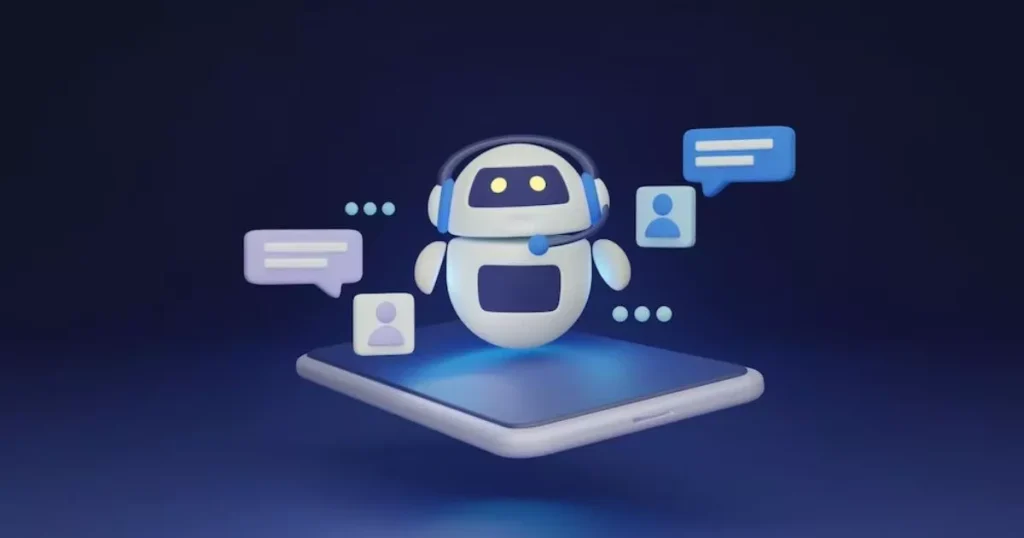AI chatbots are probably the most widely known everyday application of artificial intelligence. Client care teams love them because they handle simple requests, freeing up live agents’ time while simultaneously challenging them with more complicated tickets. In this article, we’ll explore how Python can be leveraged to build AI chatbots and their impact across various industries.
Introduction to AI Chatbots in Python

AI chatbots are computer programs that simulate human conversations through text or voice interactions. By utilizing Python in creating these chatbots, developers can benefit from the language’s vast ecosystem of AI and machine learning libraries. These libraries, like TensorFlow and NLTK, provide the necessary tools to implement natural language processing (NLP) and machine learning models efficiently, making the development of sophisticated chatbots more accessible.
Through AI chatbots, we can foresee a future where human-like virtual assistants are an integral part of our daily interactions, delivering seamless, personalized, and intelligent experiences across platforms.
The Role of Python in AI Development
Python’s role in AI is dictated by its simplicity and the extensive support it offers through libraries and community contributions. It enables seamless data analysis, model development, and integration with other services, making it a go-to choice for developers in AI chatbot creation. The versatility of Python also allows for usage in various platforms, like building a Discord AI chatbot Python style or embedding a chatbot into a web service.
Benefits of AI Chatbots for Various Industries
Incorporating AI chatbots in businesses can lead to numerous benefits:
- Customer Support: Chatbots can provide instant support, answer FAQs, and escalate complex issues to live agents.
- Healthcare: They can facilitate appointment scheduling, patient monitoring, and provide health advice.
- E-commerce: Chatbots enhance the shopping experience through personalized recommendations and support.
- Banking: They offer quick access to account information and assist with financial transactions.
How Python Developers Can Build AI Chatbots
Developers looking to build an ai chatbot python powered can follow several steps:
1. Define the purpose and functionality of your chatbot.
Determine what tasks your chatbot will perform, who its target audience is, and what specific problems it will solve. Clearly outlining its purpose helps guide the development process and ensures that the chatbot meets user needs effectively.
2. Choose the appropriate libraries and frameworks.
Select the best libraries and frameworks that fit your chatbot’s requirements. Popular choices include TensorFlow, PyTorch, and spaCy for machine learning, as well as Dialogflow and Microsoft Bot Framework for building conversational interfaces.
3. Design a conversation flow and script.
Create a detailed conversation flow that outlines how users will interact with the chatbot. Develop scripts for different scenarios and responses, ensuring that the interaction feels natural and covers a wide range of user inputs.
4. Integrate NLP capabilities for understanding user intent.
Incorporate Natural Language Processing (NLP) tools to equip your chatbot with the ability to comprehend and interpret user inputs accurately. This involves using algorithms to recognize intent, extract entities, and provide relevant responses.
5. Continuously train your AI models with diverse datasets.
Regularly update and train your AI models using diverse datasets to improve their accuracy and performance. This continuous training helps the chatbot adapt to new types of queries and enhances its understanding over time.
When considering how to make a ai chatbot in python, it’s important to select the right library. For beginners, libraries like ChatterBot allow rapid development of simple bots, while more experienced devs can utilize frameworks like Rasa for greater control over the conversation flows.
Best Practices for AI Chatbot Development in Python
Let us share some useful tips that will quicken your Python chatbot development and raise the percentage of successful deployment.
Focus on the user experience by ensuring your chatbot has a natural dialogue flow. This means programming it to understand various conversational nuances and respond in a way that feels human-like and engaging.
Keep responses concise and contextually relevant. Avoid long-winded answers that can confuse the user, and always make sure the response directly addresses the user’s query or concern.
Prioritize user privacy and data security. Implement robust security measures to protect user data and ensure that any personal information collected is handled in compliance with privacy regulations.
Regularly update the bot’s knowledge base to improve its accuracy. Continuously feed the chatbot new information and refine its algorithms to enhance its performance and keep it up to date with the latest trends and user needs.
Real-World Examples of Python-Powered AI Chatbots
Companies like Spotify and Netflix have successfully deployed Python-powered AI chatbots, providing personalized recommendations and enhancing user engagement. These conversational AI chatbot Python systems process large volumes of data to understand user preferences and improve the accuracy of their interactions.
Another noteworthy example is Starbucks’ virtual assistant, which allows customers to place and customize orders through their mobile app. This bot utilizes natural language processing to understand user preferences and provide a seamless ordering experience.
The H&M chatbot assists users in finding fashion items by offering personalized suggestions based on the user’s style and preferences.
Domino’s Pizza has developed a chatbot that can take orders through various platforms, including Facebook Messenger, providing a convenient and efficient way for customers to place orders. These real-world applications demonstrate the flexibility and effectiveness of Python-powered AI chatbots in enhancing customer experiences across different industries.
Conclusion
Python’s simplicity, extensive libraries, and active community support make it an ideal choice for building sophisticated AI chatbots, enabling developers to efficiently implement robust and scalable solutions. Regardless of the industry, Python will serve you development team’s right hand in creating a chatbot your customers will understand immediately and converse conveniently.